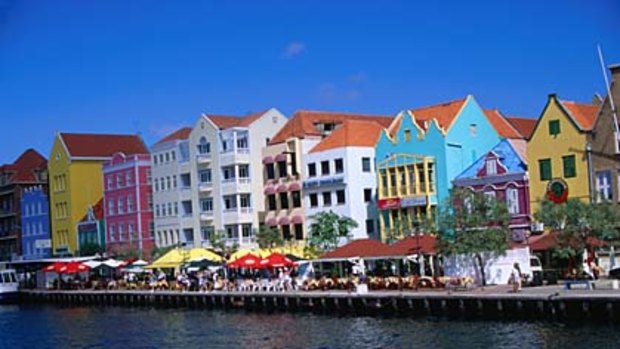
Go Dutch ... Willemstad's colourful waterfront.Credit: Lee Foster/Lonely Planet
Crystal clear waters are just one of the secret charms of Curacao, writes Ute Junker.
THE city of Willemstad makes no sense. Its cobblestone streets and its historic buildings, all long lines and curved gables, look as if they've been transplanted from Amsterdam. But its people, dark-hued and clad in bright oranges and turquoises, pinks and yellows, clearly belong in the sun-drenched tropics.
The capital of the island of Curacao is a one-of-a-kind oddity, perhaps the Caribbean's best-kept secret. Curacao is not like most Caribbean islands. Just one glimpse of its capital Willemstad confirms that. The town's beautifully preserved architecture has a unique style that might be called Caribbean colonial. The basic shapes of the buildings are a legacy of the long Dutch rule over the island; the jewel-like colours - green, gold and amethyst - are an unexpected touch of island exuberance.
There's nothing quite like it anywhere else in the Caribbean, which is why Willemstad's architecture has been recognised with a UNESCO World Heritage listing.
The two halves of the town, Punda and Otrabanda - spread out on either side of a long tongue of harbour, joined by an elegant floating pontoon bridge - are full of surprises, such as the Mikve Israel-Emanuel Synagogue. Founded in 1651 by Portuguese Jews expelled by the Inquisition, it's the oldest synagogue in the New World and has a sand-covered floor, representing the desert where Israelites camped on their way from slavery in Egypt.
The forbidding-looking forts on either side of the harbour mouth, the Riffort and the Waterfort, are now filled with a variety of shops and restaurants.
Curacao (pronounced koo-rah-sow) is in some ways the island time forgot. Once the biggest slave-trading market in the Caribbean (an excellent museum charts the history of the grisly trade), Curacao has missed out on the tourism boom that radically reshaped islands such as the Bermudas and the Bahamas. Part of that may be due to its location: Curacao is in the deep south of the Caribbean, just 70 kilometres off the Venezuelan coast.
Whatever the reason, it makes Curacao a Caribbean destination with a difference, a place that has more to offer than just the crystal-clear waters that lap the 37 white sandy bays that fringe its coast.
Fine dining, however, is not one of its drawcards. Elsewhere in the Caribbean, five-star hotels have dining rooms helmed by big-name chefs. What's on offer in Curacao is real Caribbean Creole food, served up most memorably at Willemstad's favourite lunch spot, the no-frills Marshe Bieu. Office workers queue in the converted market hall, where huge pots and pans placed over red-hot coals are filled with aromatic local specialities such as guiambo (okra soup), galina (stewed chicken), goat or fish. A few dollars buys you a hearty meal with rice and beans, cornmeal, or a delicious pumpkin pancake.
Alternatively, head to the north end of the Handelskade to pick up tropical fruits and vegetables from the brightly painted schooners moored here. The vendors at this floating market sail from Venezuela with their produce, sailing home again once the boat is empty.
There's plenty to explore beyond Willemstad. In the days when Curacao was a Dutch colony, farmers built elaborate plantation houses in the island's centre, many of which are worth a visit.
Landhuis Daniel is now a restaurant with a pretty garden setting, especially famed for its breakfasts. Landhuis Jan Kock is home to a unique gallery showcasing the colourful work of the island's most acclaimed artist, Nena Sanchez. The Landhuis has a cafe decorated by Sanchez, with elaborate, colourful murals covering every surface, including the tables and chairs. While you're there, ask directions for the nearby salt plains where a colony of flamingos is known to congregate.
The oversized hotel developments that punctuate most of the Caribbean are still scarce on Curacao: here, much of the accommodation is smaller, family-owned properties. Where you stay on the 60-kilometre-long island will depend on the scene you prefer. Party animals will head for the southern coast, where a long stretch of beach pumps to techno beats every night. For those who want to be close to the action but not too close, the Avila Hotel is set in its own quiet cove, close to both Willemstad and the popular beaches.
To really get away from it all, head to the Westpunt area, where you'll find many of the island's best beaches and one of its most luxurious hotels. The Lodge Kura Hulanda is an intimate resort with quality restaurants and a spa. You can catch the free shuttle into Willemstad or explore the nearby Christoffel National Park, where herds of white-tailed deer can be spotted.
Trip notes
Getting there
American Airlines flies to Curacao direct from Miami, with prices starting from about $US123 ($123.80).
Staying there
The Avila Hotel (luxehotels.com/hotels/Avila) is on the beach close to the capital, Willemstad. It offers apartment-style accommodation and is home to the island's best jazz club.
Lodge Kura Hulanda in Westpunt (slh.com), has a cliff-top location overlooking a white-sand beach.
More information
curacao.com.
Three things to do
1. Explore spectacular corals and marine life at Mushroom Forest, considered one of the best dives in the Caribbean.
2. Visit the Kura Hulanda Museum in Willemstad, one of the most comprehensive slavery museums in the world.
3. Trek by foot or on horseback through Christoffel National Park.
Sign up for the Traveller Deals newsletter
Get exclusive travel deals delivered straight to your inbox. Sign up now.